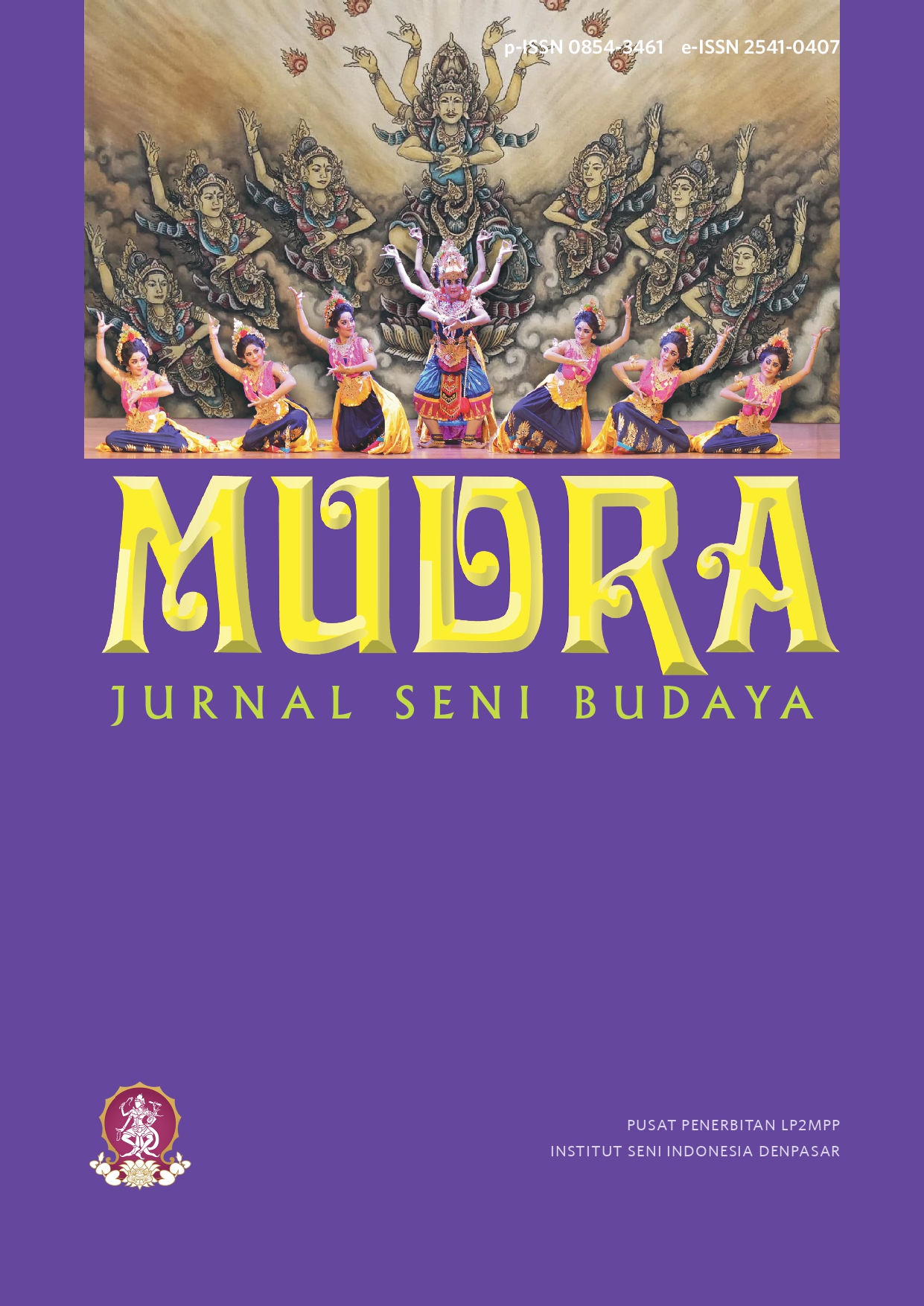Influence of Various Factors on the Development of Karawo Traditional Textiles in Gorontalo Province, Indonesia
DOI:
https://doi.org/10.31091/mudra.v38i4.2350Keywords:
Development, traditional textiles, external factors, internal factorsAbstract
This study aims to clarify the influence of various factors on the development of traditional textiles, by examining the case of the development of traditional karawo textiles in Gorontalo Province, Indonesia from 1970 to 2020. This study employs a qualitative research method with a historical approach. Data were collected through historical documents, observation, interviews, and a literature review. Data were analyzed interactively with continuous comparisons during and after data collection. The results showed that the development of traditional karawo textiles from 1970 to 2020 can be further divided into three distinct periods: 1970–2000, 2000–2010, and 2010–2020. During each period, karawo textiles were influenced by various factors, both internal and external. The most influential internal factors were the emergence of craftspeople and designers as production bases and continuous innovation. The most influential external factors were the actions of government and commercial institutions. Government policies encouraged individuals and non-governmental organizations to contribute to the development of karawo textiles. Commercial institution influent the distribution and marketing of karawo textile products. The study also describes the types of factors and their impacts. The study concludes that to ensure the sustainable development of traditional textiles, therefore those internal and external factors must consistently contribute from time to time.
Downloads
References
Arifuddin, A. (2017, July 14). Sulam Karawo Appears at New York Fashion Week: This is the Designer's Hope. Hargo, 1. https://hargo.co.id/news/karawo-tampil-di-new-york-fashion-week-ini-harapan-sang-designer.html.
Bank Indonesia. (2010). Study of Cluster Formation of Karawo Gorontalo Embroidery Crafts. (Unpublished Document). Bank Indonesia Gorontalo Office.
Bank Indonesia. (2011). Karawo Embroidery Craft Development. (Unpublished Document). Bank Indonesia Gorontalo Office.
Cohen, E. (1988). Authenticity and Commoditization in Tourism. Annals of Tourism Research, 15(3), 371-386. https://doi.org/10.1016/0160-7383(88)90028-X.
Domili, B., Tangkllisan, M.E., & Agustinus, W. (1996/1997). The Impact of Openwork Embroidery on the Social Life of the People in North Sulawesi. Manado, Indonesia: North Sulawesi Cultural Values Assessment and Development Project.
Fan, K. K., & Zhou, Y. (2020). The Influence of Traditional Cultural Resources (TCRs) on the Communication of Clothing Brands. Sustainability, 12(6), 2379. https://doi.org/10.3390/su12062379.
Fatonah, Mahdi, B., & Hartati, M. (2022). Jambi Malay Dance Fashion Aesthetics. Mudra Jurnal Seni Budaya, 37(4), 446–454. https://doi.org/10.31091/mudra.v37i4.2021.
Hall, S. (1990). Cultural Identity and Diaspora. In Jonathan Rutherford (Ed), Identity: community, culture, difference (pp.222-237). Lawrence & Wishart.
Hasdiana, Ulin N., Isnawati M., & Nining M. (2019). Engineering Design of Traditional Gorontalo Motif for Learning Karawo Embroidery. Proceedings of the 1st International Conference on Education Social Sciences and Humanities (ICESSHum 2019), 335, 327-332. https://doi.org/10.2991/icesshum-19.2019.53
Hyun, S. H., & Bae, S. J. (2007). Aesthetic characteristics of traditional Korean patterns expressed on contemporary fashion design-from 1990 to 2005. Journal of Fashion Business, 11(6), 139-156.
Jones, M., & Alony, I. (2011). Guiding the Use of Grounded Theory in Doctoral Studies–An Example from the Australian Film Industry. International Journal of Doctoral Studies, 6 (N/A), 95-114. https://doi.org/10.28945/1429.
Kielmann, K., Cataldo, F., & Seeley, J. (2012). Introduction to qualitative research methodology: A training manual. Department for International Development, UK.
Kuntowijoyo. (2003). Historical Methodology. Second Edition. Yogyakarta, Indonesia: Tiara Wacana.
Ministry of Industry. (1977). Gorontalo filigree crafts, North Sulawesi. Small Industry Echo Magazine, Third Year, 1-2.
Ministry of Industry. (1990). Karawo Handicraft Business History (Unpublished Document). Office of the Ministry of Industry, Gorontalo Regency, Indonesia.
Ministry of Industry. (1993). What is Karawo Gorontalo Embroidery? (Unpublished Document). Office of the Ministry of Industry, Gorontalo Regency, Indonesia.
Mohamad, I., Dangkua S., Botutihe S.N., & Lahinta A. (2018). Designing Contemporary Karawo Motifs for Teenagers. Journal of Arts and Humanities, 07(08), 30-37. https://doi.org/10.18533/journal.v7i8.1452
Niode, A. S., & Elnino. (2003). The Great Century of Gorontalo. Presnas Publication.
Smiers, J. (2003). Arts Under Pressure: Promoting Cultural Diversity in the Age of Globalization. Bloomsbury Publishing.
Strand, E. A (2018). Experimental Textile Archeology – A Link to the Past. In C. Ebert, M. Harlow, EA Strand & L. Bjerregaard (Eds), Traditional Textile Craft - An Intangible Cultural Heritage? (pp.77-92). University of Copenhagen: Center for Textile Research.
Sudana, I. W. (2019). Gorontalo Karawo Art: Aesthetic Forms and Concepts of Development. [Doctoral dissertation, Indonesian Institute of the Arts Surakarta] Surakarta. https://repository.isi-ska.ac.id/id/eprint/3240.
Sudana, I. W., Suparno, T. S., Dharsono, & Guntur. (2018). Method of Designing Ornaments on Karawo Textiles in Gorontalo. Proceedings of the 3rd International Conference on Creative Media, Design and Technology (REKA 2018), 207, 123-126. https://doi.org/10.2991/reka-18.2018.27
Tucman, G. (1994). Historical Social Science: Methodologies, Methods, and Meanings. In N.K. Denzin & Y.S. Lincoln (Eds.), Handbook of Qualitative Research (pp. 306–323). Sage Publications, Inc.
Waty, M. (2019). Airbrush Karawo Batik Design. Journal of Social Science Studies, 6(1), 128-140.https://doi.org/10.5296/jsss.v6i1.14159.
Downloads
Published
How to Cite
Issue
Section
License
Copyright (c) 2023 Hasdiana, I Wayan Sudana, Masayuki Sakakibara, Ni Kadek Karuni

This work is licensed under a Creative Commons Attribution-NonCommercial-ShareAlike 4.0 International License.
- Copyright on any open access article in a journal published by Mudra Jurnal Seni Budaya is retained by the author(s).
-
The Creative Commons Attribution License 4.0 formalizes these and other terms and conditions of publishing articles.









